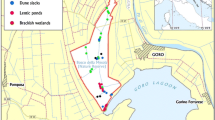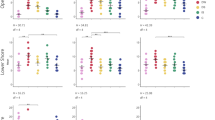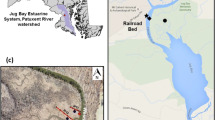Abstract
It is widely accepted that in coastal wetlands a negative relationship exists between plant species richness (number of species) and salinity. However, the distribution of species richness across estuarine salinity gradients has not been closely examined. We hypothesized that plant species richness in coastal marshes (i.e., wetlands dominated by herbaceous plants) is highest within the fresh-brackish transition zone (oligohaline salinity regime). The basis for this hypothesis was that salinity fluctuations between fresh and brackish salinities (i.e., 0–7 ppt) might promote coexistence of freshwater and salt-tolerant brackish marsh species, resulting in a peak in richness in the transition zone. We conducted an observational study across the fresh (< 0.5 ppt) to mesohaline (5–18 ppt) salinity gradients of the Nanticoke and Patuxent Rivers of Chesapeake Bay to describe the distribution of plant species richness across each estuarine gradient. A series of 1,000-m2 plots (with nested subplots) was established along 50-km sections of each river. Our results do not conclusively support our hypothesis of a transition zone peak in richness for either river gradient. However, richness in transition zone oligohaline marshes was as high as or higher than in tidal freshwater marshes, resulting in a distinctly non-linear pattern of plant species richness along the relatively undisturbed Nanticoke River. In contrast, the more urbanized Patuxent River gradient displayed a linear decrease in plant species richness with increasing distance downstream across the estuary. Hence the non-linear pattern of plant species richness observed along the Nanticoke River may be the typical pattern in relatively undisturbed estuaries.
Similar content being viewed by others
Literature Cited
Anderson, R. R., R. G. Brown, and R. D. Rappleye. 1968. Water quality and plant distribution along the upper Patuxent River, MD. Chesapeake Science 9: 145–56.
Baumann, R. H., J. W. Day, Jr., and C. A. Miller. 1984. Mississippi deltaic wetland survival: sedimentation versus coastal submergence. Science 224: 1095.
Boesch, D. F., M. N. Josselyn, A. J. Mehta, J. T. Morris, W. K. Nuttle, C. A. Simenstad, and D. J. P. Swift. 1994. Scientific assessment of coastal wetland loss, restoration and management in Louisiana. Journal of Coastal Research SI20: 1–103.
Britsch, L. D. and J. B. Dunbar. 1993. Land loss rates: Louisiana coastal plain. Journal of Coastal Research 9: 324–38.
Cardelús, C. L., R. K. Colwell, and J. E. Watkins, Jr. 2006. Vascular epiphyte distribution patterns: explaining the mid-elevation richness peak. Journal of Ecology 94: 144–56.
Chambers, R. M., L. A. Meyerson, and K. Saltonstall. 1999. Expansion of Phragmites australis into tidal wetlands of North America. Aquatic Botany 64: 261–73.
Chambers, R. M., D. T. Osgood, and N. Kalapasev. 2002. Hydrologic and chemical control of Phragmites growth in tidal marshes of SW Connecticut, USA. Marine Ecology Progress Series 239: 83–91.
Colwell, R. K. and D. C. Lees. 2000. The mid-domain effect: geometric constraints on the geography of species richness. Trends in Ecology and Evolution 15: 70–76.
Colwell, R. K., C. Rahbek, and N. J. Gotelli. 2004. The Mid-Domain Effect and species richness patterns: what have we learned so far? The American Naturalist 163: E1-E23.
Connell, J. H. 1978. Diversity in tropical rain forests and coral reefs. Science 199: 1302–10.
Costanza, R., A. Voinov, R. Boumans, T. Maxwell, F. Villa, L. Wainger, and H. Voinov. 2002. Integrated ecological economic modeling of the Patuxent River watershed, Maryland. Ecological Monographs 72: 203–31.
Cowardin, L. M., V. Carter, F. C. Golet, and E. T. LaRoe. 1979. Classification of wetlands and deepwater habitats of the United States. U.S. Fish and Wildlife Service, Office of Biological Services, Washington, DC, USA. FWS/OBS-79/31.
Crain, C. M., B. R. Silliman, S. L. Bertness, and M. D. Bertness. 2004. Physical and biotic drivers of plant distribution across estuarine salinity gradients. Ecology 85: 2539–49.
Dunn, R. K., R. K. Colwell, and C. Nilsson. 2006. The river domain: why are there more species halfway up the river? Ecography 29: 251–59.
Ferren, W. R. Jr., R. E. Good, R. Walker, and J. Arsenault. 1981. Vegetation and flora of Hog Island, a brackish wetland in the Mullica River, New Jersey. Bartonia 48: 1–10.
Gornitz, V. 1995. Monitoring sea level changes. Climate Change 31: 515–44.
Graves, J. H., R. K. Peet, and P. S. White. 2006. The influence of carbon — nutrient balance on herb and woody plant abundance in temperate forest understories. Journal of Vegetation Science 17: 217–26.
Greenberg, R., J. Maldonado, and M. V. McDonald. 2006. Tidal marshes: a global perspective on the evolution and conservation of their terrestrial vertebrates. Bioscience 56: 675–85.
Grytnes, J. A., E. Heegaard, and P. G. Ihlen. 2006. Species richness of vascular plants, bryophytes, and lichens along an altitudinal gradient in western Norway. Acta Oecologica 29: 241–46.
Hacker, S. D. and M. D. Bertness. 1999. Experimental evidence for factors maintaining plant species diversity in a New England salt marsh. Ecology 80: 2064–73.
Jetz, W. and C. Rahbek. 2001. Geometric constraints explain much of the species richness pattern in African birds. Proceedings of the National Academy of Sciences of the United States of America 98: 5661–66.
Jordan, T. 2001. Damp in Delaware with duct tape: assessing the condition of wetlands in the Nanticoke River basin. Smithsonian Environmental Research Center Newsletter 8: 1–5.
Kearney, M. S., R. E. Grace, and J. C. Stevenson. 1988. Marsh loss in Nanticoke Estuary, Chesapeake Bay. Geographical Review 78: 206–20.
Kerr, J. T., M. Perring, and D. J. Currie. 2006. The missing Madagascan mid-domain effect. Ecology Letters 9: 149–59.
Lees, D. C., C. Kremen, and L. Andriamampianina. 1999. A null model for species richness gradients: bounded range overlap of butterflies and other rainforest endemics in Madagascar. Biological Journal of the Linnean Society 67: 529–84.
McCune, B. and J. B. Grace. 2002. Analysis of Ecological Communities. MjM Software Design, Gleneden Beach, OR, USA.
Mitsch, W. J. and J. G. Gosselink. 2000. Wetlands, third edition. John Wiley and Sons, Inc., New York, NY, USA.
Odum, W. E. 1988. Comparative ecology of tidal freshwater and salt marshes. Annual Review of Ecology and Systematics 19: 147–76.
Palmer, M. W. 1993. Putting things in even better order: the advantages of canonical correspondence analysis. Ecology 74: 2215–30.
Peet, R. K., T. R. Wentworth, and P. S. White. 1998. A flexible multipurpose method for recording vegetation composition and structure. Castanea 63: 262–74.
Pennings, S. C., M-B. Grant, and M. D. Bertness. 2005. Plant zonation in low-latitude salt marshes: disentangling the roles of flooding, salinity, and competition. Journal of Ecology 93: 159–67.
Savenije, H. G. 2005. Salinity and Tides in Alluvial Estuaries. Elsevier, The Netherlands.
Silliman, B. R. and M. D. Bertness. 2004. Shoreline development drives invasion of Phragmites australis and the loss of plant diversity on New England salt marshes. Conservation Biology 18: 1424–34.
Stevenson, J. C., M. S. Kearney, and E. C. Pendleton. 1985. Sedimentation and erosion in a Chesapeake Bay brackish marsh system. Marine Geology 67: 213–23.
Stevenson, J. C. and M. S. Kearney. 1996. Shoreline dynamics on the windward and leeward shores of a large temperate estuary. p. 233–59. In K. F. Nordstrom and C. T. Roman (eds.) Estuarine Shores: Evolution, Environments and Human Alterations. John Wiley and Sons, Ltd., New York, NY, USA.
Tabacchi, E. and A-M. Planty-Tabacchi. 1996. Landscape structure and diversity in riparian plant communities: a longitudinal comparative study. Regulated Rivers: Research and Management 12: 367–390.
The Nature Conservancy. 1998. Nanticoke River Bioreserve Strategic Plan. The Nature Conservancy Maryland/District of Columbia Field Office and Delaware Field Office, Bethesda, MD, USA.
Tiner, R. W. 1993. Field Guide to Coastal Wetland Plants of the Southeastern United States. The University of Massachusetts Press, Amherst, MA, USA.
Tiner, R. W. and D. G. Burke. 1995. Wetlands of Maryland. U.S. Fish and Wildlife Service, Ecological Services, Region 5, Hadley, MA, USA and Maryland Department of Natural Resources, Annapolis, MD, USA.
Zapata, F. A., K. J. Gaston, and S. L. Chown. 2003. Mid-domain models of species richness gradients: assumptions, methods, and evidence. Journal of Animal Ecology 72: 677–90.
Zapata, F. A., K. J. Gaston, and S. L. Chown. 2005. The mid-domain effect revisited. The American Naturalist 166: 144–48.
Author information
Authors and Affiliations
Corresponding author
Rights and permissions
About this article
Cite this article
Sharpe, P.J., Baldwin, A.H. Patterns of wetland plant species richness across estuarine gradients of Chesapeake Bay. Wetlands 29, 225–235 (2009). https://doi.org/10.1672/08-111.1
Received:
Accepted:
Issue Date:
DOI: https://doi.org/10.1672/08-111.1




